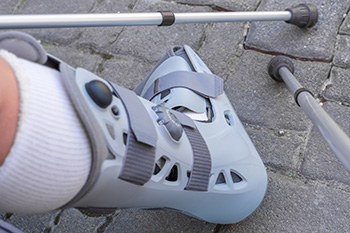
Diagnosing a broken toe involves recognizing symptoms such as intense pain, swelling, bruising, and difficulty walking. Types of toe fractures include stress fractures, where small cracks form from repetitive stress, and traumatic fractures, resulting from a direct blow or impact. A doctor will perform a physical examination and may order X-rays to confirm the diagnosis and determine the fracture type. Relief options for a broken toe include rest and elevation to reduce swelling and pain. Depending on the type of fracture, buddy-taping the injured toe to an adjacent toe may provide support and alignment during healing. Wearing stiff-soled shoes can protect the toe and ease walking. In severe cases, a cast or surgery may be necessary to ensure proper healing. If you have fractured your toe, it is suggested that you consult a podiatrist who can guide you toward a comprehensive treatment plan.
Broken toes may cause a lot of pain and should be treated as soon as possible. If you have any concerns about your feet, contact Dr. Odin De Los Reyes from Connecticut. Our doctor will treat your foot and ankle needs.
What Is a Broken Toe?
A broken toe occurs when one or more of the toe bones of the foot are broken after an injury. Injuries such as stubbing your toe or dropping a heavy object on it may cause a toe fracture.
Symptoms of a Broken Toe
- Swelling
- Pain (with/without wearing shoes)
- Stiffness
- Nail Injury
Although the injured toe should be monitored daily, it is especially important to have a podiatrist look at your toe if you have severe symptoms. Some of these symptoms include worsening or new pain that is not relieved with medication, sores, redness, or open wounds near the toe.
If you have any questions, please feel free to contact our offices located in Southbury and Farmington, CT . We offer the newest diagnostic and treatment technologies for all your foot care needs.

When facing a foot, ankle, or lower leg injury, patients often choose between a traditional hard cast and a modern air cast boot. An air cast boot, which encases the injured area in an air cushion within a hard plastic shell, offers several notable benefits. Primarily, it provides both stability and mobility. The adjustable air cells within the boot can be tailored for optimal comfort and support, reducing the risk of swelling. The boot's design also allows for limited movement, encouraging gradual weight-bearing and strength recovery. Unlike hard casts, air casts can be removed, which makes activities like showering easier. Additionally, the hard shell provides protection against impact, while the non-skid sole provides safety and stability. Air cast boots are versatile, suitable for minor injuries, and can be used as transitional support after a hard cast is removed. They are lightweight, customizable, and affordable. If you have a broken foot or ankle injury, it is suggested that you schedule an appointment with a podiatrist to see if an air cast is right for you.
A broken foot requires immediate medical attention and treatment. If you need your feet checked, contact Dr. Odin De Los Reyes from Connecticut. Our doctor can provide the care you need to keep you pain-free and on your feet.
Broken Foot Causes, Symptoms, and Treatment
A broken foot is caused by one of the bones in the foot typically breaking when bended, crushed, or stretched beyond its natural capabilities. Usually the location of the fracture indicates how the break occurred, whether it was through an object, fall, or any other type of injury.
Common Symptoms of Broken Feet:
- Bruising
- Pain
- Redness
- Swelling
- Blue in color
- Numbness
- Cold
- Misshapen
- Cuts
- Deformities
Those that suspect they have a broken foot shoot seek urgent medical attention where a medical professional could diagnose the severity.
Treatment for broken bones varies depending on the cause, severity and location. Some will require the use of splints, casts or crutches while others could even involve surgery to repair the broken bones. Personal care includes the use of ice and keeping the foot stabilized and elevated.
If you have any questions please feel free to contact our offices located in Southbury and Farmington, CT . We offer the newest diagnostic and treatment technologies for all your foot and ankle needs.
 Foot stress fractures are tiny cracks, usually found in the long bones of the foot, that result from repetitive force or overuse. These fractures often occur in athletes and individuals who engage in high-impact activities like running or jumping. Risk factors can include a sudden increase in activity intensity, wearing improper footwear, and conditions like osteoporosis that weaken bones. Stress fractures develop when muscles become fatigued and lose their ability to absorb shock, transferring the impact to the bones. Common sites for these fractures are the metatarsal bones, which bear significant weight during movement. Symptoms often include pain, swelling, and tenderness that worsen with activity. Early diagnosis is vital for healing and preventing further complications. If you have foot pain after bouts of exercise, it is suggested that you contact a podiatrist who can accurately diagnose and treat stress fractures.
Foot stress fractures are tiny cracks, usually found in the long bones of the foot, that result from repetitive force or overuse. These fractures often occur in athletes and individuals who engage in high-impact activities like running or jumping. Risk factors can include a sudden increase in activity intensity, wearing improper footwear, and conditions like osteoporosis that weaken bones. Stress fractures develop when muscles become fatigued and lose their ability to absorb shock, transferring the impact to the bones. Common sites for these fractures are the metatarsal bones, which bear significant weight during movement. Symptoms often include pain, swelling, and tenderness that worsen with activity. Early diagnosis is vital for healing and preventing further complications. If you have foot pain after bouts of exercise, it is suggested that you contact a podiatrist who can accurately diagnose and treat stress fractures.
Activities where too much pressure is put on the feet can cause stress fractures. To learn more, contact Dr. Odin De Los Reyes from Connecticut. Our doctor can provide the care you need to keep your pain free and on your feet.
Dealing with Stress Fractures of the Foot and Ankle
Stress fractures occur in the foot and ankle when muscles in these areas weaken from too much or too little use. The feet and ankles then lose support when walking or running from the impact of the ground. Since there is no protection, the bones receive the full impact of each step. Stress on the feet can cause cracks to form in the bones, thus creating stress fractures.
What Are Stress Fractures?
Stress fractures occur frequently in individuals whose daily activities cause great impact on the feet and ankles. Stress factors are most common among:
- Runners
- People affected with Osteoporosis
- Tennis or basketball players
- Gymnasts
- High impact workouts
Symptoms
Pain from the fractures occur in the area of the fractures and can be constant or intermittent. It will often cause sharp or dull pain with swelling and tenderness. Engaging in any kind of activity which involves high impact will aggravate pain.
If you have any questions please feel free to contact our offices located in Southbury and Farmington, CT . We offer the newest diagnostic and treatment technologies for all your foot and ankle needs.

